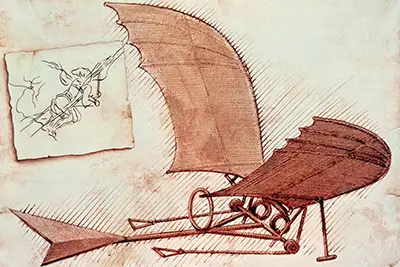His Flying Machine helps to remind us of just that.
Leonardo da Vinci was also a scientist, engineer and inventor amongst other things. We think of him today as being someone who was ahead of his time.
His genius led to him producing drawings for several ground-breaking inventions, including the Flying Machine, long before others did the same.
Early Flight
It was during the 15th century that people thought that flight was possible if they could imitate the action of birds when flying.
In his lifetime Leonardo da Vinci produced many journal entries and drawings relating to both human and avian flight.
From his writings and drawings, it appears that he also had a desire to fly through the air like a bird. An event when he was a child that involved a hawk may have been the thing that led to his ideas about flying.
The desire to fly shows itself in the many studies and drawings that Leonardo da Vinci produced. Within his journals are different design ideas he had for wings.
Through his detailed study, his work uses the principles of the nature of flight as something that man could reproduce. This led to him basing his designs for the flying machine on the anatomy of birds and bats.
In his drawings, he used bats wings as the starting point as he saw them as not being as heavy because of the nature of the membrane they have on their wings.
In his study of flight, Leonardo da Vinci came up with over a hundred drawings and sketches relating to flight. The result was him coming up with several different designs for a flying machine.
One of these was for a machine that would lift up into the air using a man-powered rotor. The design is unique as it was for a type of device that would later evolve in to what we know as the helicopter.
In his study of flight, Leonardo da Vinci also designed a parachute and a lightweight hang glider.
His Drawings – Flying Machine
When he began his study of birds in flight, Leonardo da Vinci realised that humans are too heavy. Because of this, they would not be strong enough to fly if they were only using wings attached to the arms.
He envisaged that to achieve flight there would be a need to include levers, pedals and pulleys. On this basis, in about 1490 Leonardo da Vinci drew his up plans for a flying machine that would keep a man in the air by the beating of its wings.
If you look at the plan in the drawing, it shows a pair of giant wings that connect to a wooden frame. The pilot would lie face down inside the frame on a board.
Using his hands, the pilot would grip a stick coming down from each wing for direction control. As there was no engine, to achieve flight, the pilot would make a flapping motion by pushing his legs downwards with his feet held in two spurs.
This is visible in the insert above the main drawing of the device.
What is common amongst da Vinci’s designs for a flying machine is that they are nearly all ornithopters. This meant that his designs were for a machine that had flexible wings like that of a bird or a bat.
He focused on designing mechanical systems that would make use of the pilots own physical power to keep both them and the machine in the air.
Without an engine and given the size of the wings, it is unlikely that such a machine would have ever gotten off the ground. Even if, by chance, it was possible there is no guarantee that it could have landed in one piece.
Ahead of his time
As a scientist, engineer and inventor the ideas that Leonardo da Vinci had were clearly ahead of his time. From his journal entries, and his drawings, they show how he was able to combine his skills as both an inventor and someone able to turn his ideas into designs.
His ideas were many years ahead of others.
In addition to his designs for the Flying Machine, Leonardo da Vinci also came up with ideas for other inventions. His ideas did not stop at just flight.
During his career, his notes and journals show that his studies were in a wide range of areas such as Science, Anatomy, Hydrodynamics, and mathematics to name but a few.
With his wide-ranging knowledge, Leonardo da Vinci came up with designs for things like the helicopter, the tank, the double hull plus all manner of inventions like an automated bobbin winder for example.
Some of the things we see and use today can be traced back to Leonardo da Vinci.


